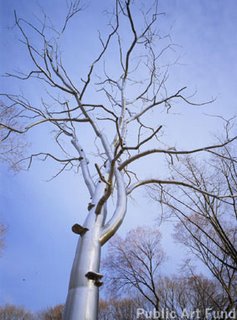Sycamores
 Russian nuclear-powered icebreaker as Kathan Brown. (The trip would later inspired Kathan’s lovely, eponymous book, published by Crown Point in 2004.) Since he knew Kathan, the geophysicist stopped by
Russian nuclear-powered icebreaker as Kathan Brown. (The trip would later inspired Kathan’s lovely, eponymous book, published by Crown Point in 2004.) Since he knew Kathan, the geophysicist stopped by John Chiara, 24th at Carolina (left variation), 2006. Photogravure on gampi paper chine colle. Paper size: 32-3/4 x 27-3/4"; image size: 23-1/2 x 19-3/4". Edition 15. Printed by Dena Schuckit.
“It’s a sycamore tree,” the geophysicist said, referring to the foreground of Chiara’s beautiful
This reminded him of another, stronger sycamore. “Do you know about the fake sycamore in Central Park, in 
The tree’s name was Bluff. It was constructed by the artist Roxy Paine and commissioned by the New York Public Art Fund in 2002. The website for Bluff reads, "Roxy Paine's Bluff was a fifty-foot high tree made of brilliantly stainless steel. Bluff's heavy industrial plates formed a two-foot-wide trunk that supported more than 5000 pounds of cantilevered branches, welded together from 24 different diameters of steel pipes and rods. Its gleaming frame remained unchanged as its environment shifted from winter into spring. By announcing its grand manmade artifice rather than attempting to blend in with the surrounding real plants and trees, Bluff was a cunning reminder that Central Park is itself an artificial sanctuary, a product of city planners as much as Mother Nature."
I recently moved to a neighborhood 5 miles from Crown Point Press,  like a sanctuary of the artificial.
like a sanctuary of the artificial.
Tom Marioni, New Growth, 2006. Color drypoint with flat bite etching. Paper size: 22 x 20-1/2"; image size: 13 x 12-1/2". Edition 20. Printed by Dena Schuckit.
Learning about the construction of the park made me think of the Crown Point gallery itself as a kind of 'sanctuary of the artificial.' Here we have two artists, John Chiara and Tom Marioni, who have each created their own series of conceptual 'landscapes'. Critic Thomas McEvilly has written of Marioni's works that they "demystify, diminish, and bring down to earth the solemnity of the sublime." Because the artists have created what they depict (Chiara moved his hand in front of the lens of his camera to get the exposure he wanted; for New Growth, pictured at left, Marioni accumulated visceral dig after dig in his copper plate), their landscapes, though artificial, are more human than landscape itself.
- Rachel Lyon

